#chromatids
Explore tagged Tumblr posts
Text
Amount of DNA Ex 2
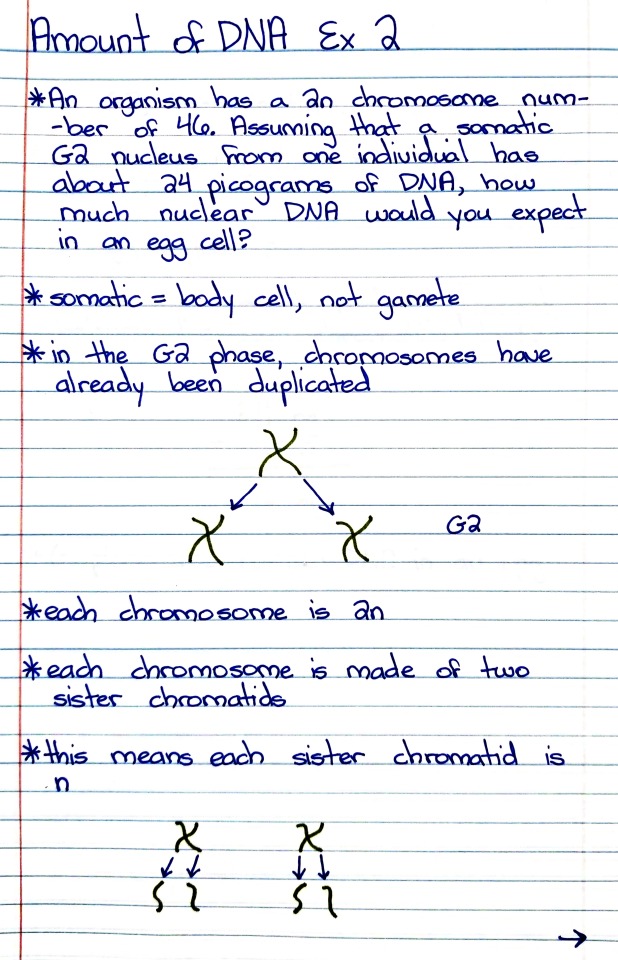

Patreon
#studyblr#notes#genetics#medblr#medical notes#med notes#genetics notes#biology#bio#bio notes#biology notes#mcat#mcat biology#mcat genetics#mcat bio#mcat studyblr#genetic material#chromatids#chromosomes#dna
2 notes
·
View notes
Text

Sisters in Arms
Studying in human cells the detailed structure of sister chromatids – the identical copies of a chromosome as DNA is replicated – during the cell cycle and division
Read the published research paper here
Image from work by Paul Batty and colleagues
Institute of Molecular Biotechnology of the Austrian Academy of Sciences (IMBA), Vienna BioCenter (VBC), Vienna, Austria
Image originally published with a Creative Commons Attribution 4.0 International (CC BY 4.0)
Published in The EMBO Journal, June 2023
You can also follow BPoD on Instagram, Twitter and Facebook
#science#biomedicine#biology#cell division#cell cycle#dna#chromosomes#sister chromatids#immunofluorescence
6 notes
·
View notes
Text

The Research Notebooks of S. Sunkavally, page 337.
#aqueous humour#flowing stream#intraocular pressure#suspensory ligaments of the lens#pancreatic hormones#glucagon#leucine#control of transcription#omnivore#sister chromatid exchanges#hypoglycemia#epinephrine secretion#vagus nerve#acetylcholine#parathyroid hormone#osteoporosis#blood calcium level#blood magnesium level#satyendra sunkavally#theoretical biology#manuscript
0 notes
Text
Most normal Star Wars fan (I’m rereading lesser evil in my biomed class)
#Meiosis??? Chromatids????? Monosomy?????? TRISOMY??????? IDFK I’m READING#turtledove yells into the abyss
0 notes
Text
october 5th - virginity loss w/ kuroo, isagi, nanami
content warnings - virginity loss, swearing, fingering, edging, slight orgasm denial, praise, intercourse?
MDNI!

tetsuro kuroo

Kuroo slouched against the wall, his biology textbook open but his eyes glazed over. He absentmindedly flipped through the pages, clearly more interested in the clock on the wall than the material. His hand, however, moved all but lethargic.
You weren't paying attention before and kept zoning out, so he found a way to force your focus on him; by pumping his fingers into your cunt, yet keeping you from rolling over the edge. Truth was, Kuroo could tell just by the way you acted that you were a virgin, so any little stroke or touch would almost be too much for you. He had you sit on the desk with spread legs while he tortured you.
“Okay, so mitosis. You know that, right?” He flipped to a colorful diagram in the book and pointed with his freehand.
“It’s, uh, how a cell divides.” you barely managed to say while his thumbs lazily prodded at your bud of nerves.
He pointed to a diagram with a half-hearted gesture. “This is prophase. Basically, the chromatin condenses into chromosomes, and the nuclear envelope starts to break down. Got that?”
You nodded, trying to keep up, but also feeling that knot in your stomach building up again. Kuroo barely glanced up from the book but could feel how tightly you were squeezing him. So he paused his movements and kept reading, causing you to whine.
“Then there’s metaphase, where the chromosomes line up at the cell's equator. It’s like they’re getting ready for a race, but honestly, who cares?” he took the opportunity to look up at you with mock disappointment at your earlier distracted state.
Kuroo let out a small sigh before he began pumping his fingers again, flipping the page with little enthusiasm. “After that, you have anaphase. The sister chromatids get pulled apart. You know, like a tug-of-war that nobody really wants to play.”
He could feel you grinding your hips against his hand but kept reading. “Then there’s telophase. The chromosomes de-condense, and the nuclear envelope forms again. It’s kind of like tidying up after a party, but without the fun.”
Kuroo glanced at the you again, his expression a mix of boredom and mild curiosity as mentally captured your face. “What's the final stage, little miss airy?” he challenged you to answer as he could see your face contorting again.
“Um. Uh- Cytokinesis?” you barely remembered him brabbering on about it the first time.
“Very good.” He smirked as he finally let you cum.
yoichi isagi

The door creaked ominously as he pushed it open, revealing a dimly lit room that felt heavy with tension. Shadows danced along the walls, their flickering forms mirroring the uncertainty swirling in his mind. You sat up on the bed, your heart racing, aware of the familiar dynamic but sensing the weight of this moment. Today felt different; an unspoken significance lingered in the air.
As he stepped inside, the door clicked shut behind him, sealing off the world outside. You could practically taste his nervousness, a palpable energy that hung between you like fog. His hands fidgeted at his sides, and each tentative step he took echoed. He paused, caught between desire and doubt, as the gravity of the moment pressed down on both of you. It was a crossroads, a threshold to something new, and the air crackled with anticipation.
He wasn't about to concede to his anxiety as he had down many times before. Today was the day.
“You sure you’re ready, Isagi?” Your voice was low and sultry, wrapping around him like velvet as you swung your legs off the bed. The soft rustle of sheets filled the air, mingling with the faint scent of anticipation that permeated the room. You recalled the conversation you both shared earlier, a mix of playful teasing and earnest vulnerability about his desire to finally lose his virginity.
He gulped hard, the sound echoing in the stillness, before taking another hesitant step forward. “I… I’m sure,” he replied, his voice barely a whisper, trembling like the flickering candlelight. His breath hitched in his throat as you approached, the warmth radiating from your body creating an intoxicating haze around him. The air buzzed with electricity, and the faint thump of his heartbeat echoed in your ears, a rhythm that mirrored the growing intensity of the moment. You reached out and placed a delicate hand on his shoulder.
“I’ll be gentle with you, ‘ichi,” you murmured, your voice soft and soothing as your hands glided over his shoulder, feeling the warmth of his skin beneath your fingertips. You let your touch trail delicately up his neck, feeling the subtle tension in his muscles beneath your palm. The heat radiating from him sent a thrill through you, amplifying the intimacy of the moment.
“Just trust me, okay?” you continued, locking your gaze onto his, your eyes steady and reassuring. The world outside faded away, leaving only the two of you suspended in this charged space. His breath quickened slightly, and you could see the vulnerability in his expression, a mix of anticipation and trepidation. He nodded, a small movement filled with unspoken trust, and in that moment, you felt the weight of his surrender.
kento nanami

"Just relax, darling," Nanami whispered softly into your ear, his breath warm and gentle against your skin. The way he spoke sent a shiver down your spine, a soothing balm against the tension that coiled within you. His voice was low and melodic, wrapping around you like a comforting embrace.
You could feel the heat radiating from his body, the subtle rise and fall of his chest brushing against yours. Despite the softness of his words, you were acutely aware of how tightly you were holding onto him, your muscles taut and rigid. The room was dimly lit, shadows dancing around you, creating an intimate cocoon that felt both safe and electric.
“You're doing so well for me already,” he continued, his voice a gentle caress that urged you to let go. The scent of him—warm musk mixed with a hint of fragrant citrus—filled your senses, grounding you even as your heart raced.
With each breath he took, you felt his warmth seep deeper into your being, coaxing you to melt against him. He placed a hand on your back, his touch firm yet tender, guiding you to ease the tension that gripped you so fiercely. The way his fingers lingered sent electric tingles through your skin, igniting every nerve ending and urging you to open up.
"Just breathe," he murmured, the cadence of his voice like a rhythmic lullaby. The world outside faded away, leaving only the two of you suspended in this moment, where nothing else mattered but the connection between your bodies and the quiet intimacy of his urging whispers. Once you finally stopped clenching so hard, he was able to pull out again and slowly re-enter. “There we go.” He kissed your jaw gently. “You're doing a good job.”

#nanami kento#x f!reader#blue lock#haikyuu#haikyu#haikyuu x reader#kuroo tetsurou#kuroo x reader#haikyuu kuroo#jjk smut#jjk#jjk x reader#jjk nanami#nanami smut#nanami x reader#jujutsu kaisen#bllk isagi#isagi x you#isagi x reader#blue lock isagi#isagi yoichi#yoichi isagi#x reader#anime#bllk smut#bllk x you#bllk x reader#hq smut#hq#degredation kink
340 notes
·
View notes
Text
a second microtubule has hit the sister chromatid
170 notes
·
View notes
Text
Propaganda!


Granulocytes are cells in the innate immune system characterized by the presence of specific granules in their cytoplasm. There are four types of granulocytes (full name polymorphonuclear granulocytes): Basophils, eosinophils, neutrophils, and mast cells. Except for the mast cells, their names are derived from their staining characteristics; for example, the most abundant granulocyte is the neutrophil granulocyte, which has neutrally staining cytoplasmic granules.
In cell biology, the spindle apparatus is the cytoskeletal structure of eukaryotic cells that forms during cell division to separate sister chromatids between daughter cells. It is referred to as the mitotic spindle during mitosis, a process that produces genetically identical daughter cells, or the meiotic spindle during meiosis, a process that produces gametes with half the number of chromosomes of the parent cell.
#Granulocytes#Spindle fibers#tournament poll#polls#wikipedia#cells of the human body#science tournament#biochemistry#poll#tumblr poll#tumblr polls
10 notes
·
View notes
Text
WIP Wednesday!
A bit of a change of pace. I've been going back every-so-often to this WIP of an original fic I've been writing since 2017. It's my baby but I want to kick it out of my house now, lol!
I held the door handle in my hand, the cool metal leaving a ghostly impression on my hand, just barely out of reach. I was uncertain whether I should take the plunge and meet the one Raz covertly warned me about or if I should ignore the call entirely, head home, and bury myself in the back parking lot. I knew I had very little choice in the matter –my hand clasped around the rather plain looking nob and I twisted it. I was instantly greeted by him; his back was turned and his secretary was long gone but it was clear.
"I'm glad you could come Svetvana. I know travelling here isn't always pleasant; cold compared to home. Certainly cold compared to the Left," he began speaking to the glass, his tower overlooking his expending universe.
"You don't dye your hair," I commented brashly.
"What?" He snapped, his head turning a quarter of the way over.
"I remember a young man... a younger man who liked to colour his hair black but it would always come out a shade lighter than strawberry blonde." He started to laugh, his teeth sinking deep into his tongue. "You're not that old."
"Neither are you, I think. You just might look that way."
The laughing stopped. "You talk too much. Amram seems to think it's a quirky and cute trait. I think it's deplorable. Against the Greater Good."
I automatically took offense, something primal. "The Greater Good is what I work towards."
He turned from the window, with one hand adjusting his tie and the other turning his chair around, he sat facing me. Even sitting down he towered over me, his broad arms taking charge over his domain: the oak desk. "Really? Well, I suppose that's why you're here with us and not with them." He gestured to the chair at the other end of the desk, asking me to sit. I sat in the chaise, feeling the abrasive gold fabric press into my bare forearms. His red eyes scanned me over before he fished in his coat pocket and pulled out a handkerchief. Lifting it to his lips, he let out a cackle of a cough, a thickness rattling his frame, making him appear frail.
"Have you been coughing for that long?" I saw in his eyes, he wanted to lash out at me but instead he folded up his handkerchief, sat upright and gathered his composure.
"It's acute bronchitis."
I nodded in sympathy before he continued, "I heard from Amram what you have been doing for him."
"What has he been telling you?" I interrupted.
"Very interesting things. I think it's brilliant. Useless. But brilliant."
"You don't believe this is for the Greater Good."
"No. In fact, I think it's very counterintuitive to everything we are doing here."
"It's about spreading knowledge. Revealing a world that we would otherwise misunderstand."
"Do you think that now?" He retorted. "Please Svetvana, once you have completed your research and you write this entry, what then? What will happen when people will read it?"
I shrugged, "they will read it, like any other entry. I'm not sure of your question," but somehow I knew exactly what he was insinuating.
"Exactly. You don't know. But I do. And do you know why? Because that is what I do. I inherited our fathers' land. I know what the collectiveness of our society will do. I anticipate it. I work with these intricacies to bring about peace, prosperity and calm. Total calm. Something that your entry will threaten."
"Everyone knows about the Left. I don't see how me talking about it in a more contemporary setting will upset some balance."
A smirked spread across his entire face, his facial hair doing very little to camouflage. "No one knows about the Left. Everyone thinks they know, but they don't. You've seen it. How they grovel in their own filth." His fist slammed hard on the table, "I was tasked of taking care of the Right Chromatid, and I'll do just that. I just wanted to make that abundantly clear to you, Svetvana."
4 notes
·
View notes
Text
Hehe sister chromatids are shaped like ♓️
8 notes
·
View notes
Text
I still haven’t moved on from finding out today that there is a tiktok trend of people INGESTING BORAX.

I ended up going down this rabbit hole to find out where people are getting this information and immediately found this:
https://www.lybrate.com/topic/borax-benefits-and-side-effects


These are real doctors from India with masters who work in the states and such, I did a brief bg check on them. What the fuck? This is the only thing I could find that states borax has “health benefits”. But wait... in the fine print at the bottom:

I kept digging for more and found this article by the Jerusalem Post stating the possible origin of this trend. Dr. Rex E. Newnham has been cited by many tiktokers for having written several papers claiming that borax had health benefits but the research showing results is difficult to find. From these papers, a conspiracy has spawned and now people have become convinced Newnham was onto something and was blocked by big pharma so they could continue making billions.
Now here’s some information you mostly will find online when researching borax:


FUN FACT: Borax is actually banned in several countries because it has been suggested that it can cause cancer and multi-organ accumulation of poisoning. Kids have actually died playing with slime activated by borax. (src)

Studies conducted by NLM (National Library of Medicine) on people who consumed borax show “immune cell proliferation and sister chromatid exchange in human chromosomes”.. In other words: “Toxicity of borax may lead to cellular toxicity and genetic defect in human.” (src)
Here’s what I now know based on most research that can be pulled of borax:
-it is not boric acid, it is also NOT boron. boron is only one component of borax. -classified as a mild skin irritant and can even cause chemical burn -banned by FDA as a food additive. -can be used as a component in pesticides, flame retardant, enamel glazes, glass, ceramics, laundry detergent etc. -has potential to disrupt the reproductive system shown in studies of mice and hemorrhagic gastroenteritis in cattle. (src) -like anything else, bad for you in large quantities or in long-term use but this is actually classified as poisonous and there are more studies that show this than anything opposing. -just because it’s natural doesn’t mean it’s safe for consumption
Folks, if you have joint pain, look into MSM supplements or powder for more potency which is an anti-inflammatory agent that the FDA has recognized as generally safe for consumption under 4000 mg/day with little to no known side effects. You should consult with your doctor before taking any supplements realistically but for the love of god, do not consume borax.
23 notes
·
View notes
Text
i'm sooo out of the loop... what is jon mess's upper thigh tattoo? i swear it is a diagram of chromatids
#also the tilian shade in that video is very nice#no one misses you 🖤#anyways tags for visibility surely someone has seen him in little hotpants and has an answer#jon mess#dance gavin dance
5 notes
·
View notes
Text
Mitosis Stages
-- has four phases
Prophase -- duplicated chromosomes coil up -- nucleus and nucleolus disappear -- spindle apparatus is completed -- chromosomes go to the center of the cell
Metaphase -- centromeres line up on the metaphase plate
Anaphase -- centromeres split -- chromatids move to opposite spindle poles
Telophase -- chromosomes uncoil -- nucleus and nucleoli form -- spindle apparatus is undone -- cytokinesis is complete
#medblr#studyblr#notes#my notes#medical notes#medblr notes#med notes#anatomy and physiology#anatomy#physiology#anatomy notes#physiology notes#biology#biology notes#bio#bio notes#mitosis#mitosis notes#cytokinesis#cytokinesis notes
11 notes
·
View notes
Text
A Midcellmmer Night’s Dream
Our cell membranes press against each other, and I know I’m in love. Accurate to their name, G2trude is in the G2 phase of the cell cycle. Through their semipermeable cell membrane, I can see enzymes checking that their genetic information is all correct. If I had cheeks and blood to blush with right now, I would. Unlike G2trude, I am only in the G1 phase. I’m still growing, developing organelles, and other things that probably seem super juvenile to G2trude. Hey, someday they’ll be back to where I am though. Kinda. Soon enough, they’ll go into mitosis and after that they’ll be 2 daughter cells in G1. Will they both be G2trude then? Or just one? Or are they completely their own cells? Who really knows, philosopher cells don’t come around these parts. Or any parts, they don’t exist.
It would be easier if we were gametes. We wouldn’t go thru mitosis, and we could be together and be together forever. However, we are skin cells, stuck in the epidermis, stuck in the cell cycle.
We, us, G2trude and Trevor
stuck in cell cycle forever
G1, S, G2, mitosis
believing you love me is psychosis
Something happens! I watch centrioles head to opposite sides of the cell. Oh man, mitosis already? Maybe our phase gap isn’t that bad after all! I watch in silence, for I am a cell and have nothing to make noise with, as G2trude starts prophase. From the centrioles spring forty spindle fibers. The nuclear envelope breaks down, and the chromosomes line up in the middle. I watch in fear and fascination. I can’t believe I’m witnessing this coming of phase. The spindle fibers grab onto the centromeres and pull them apart. I CAN’T WATCH!!! But I do anyway. Oh golly gee, G2trude isn’t their usual shape anymore! They look like two suns, still attached at the side. If only they e could merge together like that! Only gametes merge though. As said before, we are skin cells stuck in the epidermis.
We, us, G2trude and Trevor
stuck in th’epiderm forever
If we were gametes we’d be one
Mr. and Mrs. Trevor, why, that’s fun!
The nuclear envelopes are forming again, around the chromatids. Then, I watch as G2trude is no more. If I had tears to cry with, I would cry. No. SOB. I now know that neither of them is really my G2trude. They’re their own cells. I’ll name them Epinand Dermis.
G2trude isn’t the only one who’s changed however. I’m now in S phase. Synthesizing phase. My DNA is getting replicated into perfect copies. Soon, I’ll be in G2 phase just like G2trude was. Then in M phase: Then G1 again. That’s cell cycle for you. Never ending, never escapable. Predetermined.
This is the story of G2trude and Trevor,
Now it’s time to say cellut forever
#cell#cell cycle#biology#crack fic#fanfiction#cell cycle fanfiction#yearning#this is a summative grade for my biology class#no i am not joking#writblr#writerblr#creative writing#writers of tumblr#writing community
3 notes
·
View notes
Text
Mitosis Help- College Biology (AP)
Introduction
What do your intestines, the yeast in bread dough, and a developing frog all have in common? Among other things, they all have cells that carry out mitosis, dividing to produce more cells that are genetically identical to themselves.
Why do these very different organisms and tissues all need mitosis? Intestinal cells have to be replaced as they wear out; yeast cells need to reproduce to keep their population growing; and a tadpole must make new cells as it grows bigger and more complex.
What is mitosis?
Mitosis is a type of cell division in which one cell (the mother) divides to produce two new cells (the daughters) that are genetically identical to itself. In the context of the cell cycle, mitosis is the part of the division process in which the DNA of the cell's nucleus is split into two equal sets of chromosomes.
The great majority of the cell divisions that happen in your body involve mitosis. During development and growth, mitosis populates an organism’s body with cells, and throughout an organism’s life, it replaces old, worn-out cells with new ones. For single-celled eukaryotes like yeast, mitotic divisions are actually a form of reproduction, adding new individuals to the population.
In all of these cases, the “goal” of mitosis is to make sure that each daughter cell gets a perfect, full set of chromosomes. Cells with too few or too many chromosomes usually don’t function well: they may not survive, or they may even cause cancer. So, when cells undergo mitosis, they don’t just divide their DNA at random and toss it into piles for the two daughter cells. Instead, they split up their duplicated chromosomes in a carefully organized series of steps.
Phases of mitosis
Mitosis consists of four basic phases: prophase, metaphase, anaphase, and telophase. Some textbooks list five, breaking prophase into an early phase (called prophase) and a late phase (called prometaphase). These phases occur in strict sequential order, and cytokinesis - the process of dividing the cell contents to make two new cells - starts in anaphase or telophase.

Stages of mitosis: prophase, metaphase, anaphase, telophase. Cytokinesis typically overlaps with anaphase and/or telophase.
You can remember the order of the phases with the famous mnemonic: [Please] Pee on the MAT. But don’t get too hung up on names – what’s most important to understand is what’s happening at each stage, and why it’s important for the division of the chromosomes.
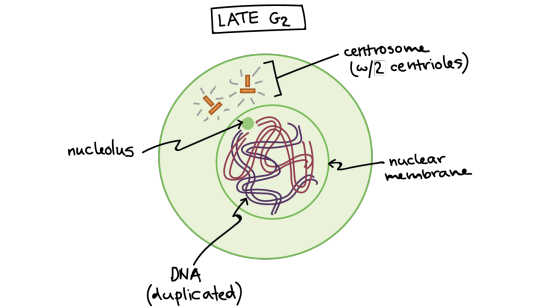
Late G2 phase. The cell has two centrosomes, each with two centrioles, and the DNA has been copied. At this stage, the DNA is surrounded by an intact nuclear membrane, and the nucleolus is present in the nucleus.
Let’s start by looking at a cell right before it begins mitosis. This cell is in interphase (late G\[_2\] phase) and has already copied its DNA, so the chromosomes in the nucleus each consist of two connected copies, called sister chromatids. You can’t see the chromosomes very clearly at this point, because they are still in their long, stringy, decondensed form.
This animal cell has also made a copy of its centrosome, an organelle that will play a key role in orchestrating mitosis, so there are two centrosomes. (Plant cells generally don’t have centrosomes with centrioles, but have a different type of microtubule organizing center that plays a similar role.)

Early prophase. The mitotic spindle starts to form, the chromosomes start to condense, and the nucleolus disappears.
In early prophase, the cell starts to break down some structures and build others up, setting the stage for division of the chromosomes.
The chromosomes start to condense (making them easier to pull apart later on).
The mitotic spindle begins to form. The spindle is a structure made of microtubules, strong fibers that are part of the cell’s “skeleton.” Its job is to organize the chromosomes and move them around during mitosis. The spindle grows between the centrosomes as they move apart.
The nucleolus (or nucleoli, plural), a part of the nucleus where ribosomes are made, disappears. This is a sign that the nucleus is getting ready to break down.
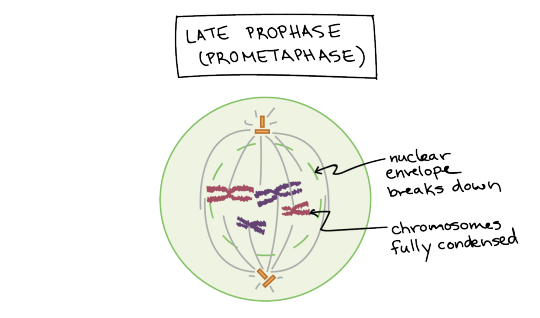
Late prophase (prometaphase). The nuclear envelope breaks down and the chromosomes are fully condensed.
In late prophase (sometimes also called prometaphase), the mitotic spindle begins to capture and organize the chromosomes.
The chromosomes become even more condensed, so they are very compact.
The nuclear envelope breaks down, releasing the chromosomes.
The mitotic spindle grows more, and some of the microtubules start to “capture” chromosomes.

Anatomy of the mitotic spindle. Diagram indicating kinetochore microtubules (bound to kinetochores) and the aster. The aster is an array of microtubules that radiates out from the centrosome towards the cell edge. Diagram also indicates the centromere region of a chromosome, the narrow "waist" where the two sister chromatids are most tightly connected, and the kinetochore, a pad of proteins found at the centromere.
Microtubules can bind to chromosomes at the kinetochore, a patch of protein found on the centromere of each sister chromatid. (Centromeres are the regions of DNA where the sister chromatids are most tightly connected.)
Microtubules that bind a chromosome are called kinetochore microtubules. Microtubules that don’t bind to kinetochores can grab on to microtubules from the opposite pole, stabilizing the spindle. More microtubules extend from each centrosome towards the edge of the cell, forming a structure called the aster.
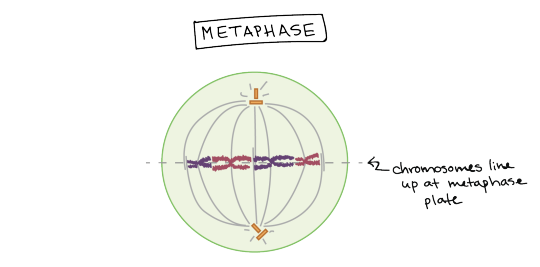
Metaphase. Chromosomes line up at the metaphase plate, under tension from the mitotic spindle. The two sister chromatids of each chromosome are captured by microtubules from opposite spindle poles.
In metaphase, the spindle has captured all the chromosomes and lined them up at the middle of the cell, ready to divide.
All the chromosomes align at the metaphase plate (not a physical structure, just a term for the plane where the chromosomes line up).
At this stage, the two kinetochores of each chromosome should be attached to microtubules from opposite spindle poles.
Before proceeding to anaphase, the cell will check to make sure that all the chromosomes are at the metaphase plate with their kinetochores correctly attached to microtubules. This is called the spindle checkpoint and helps ensure that the sister chromatids will split evenly between the two daughter cells when they separate in the next step. If a chromosome is not properly aligned or attached, the cell will halt division until the problem is fixed.
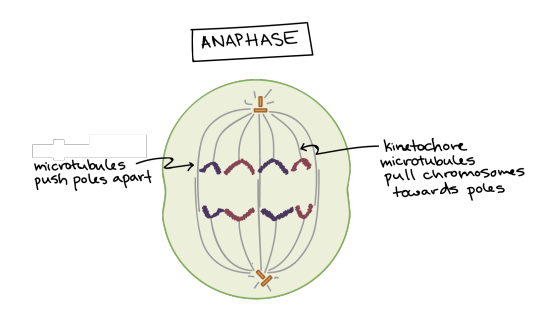
Anaphase. The sister chromatids separate from one another and are pulled towards opposite poles of the cell. The microtubules that are not attached to chromosomes push the two poles of the spindle apart, while the kinetochore microtubules pull the chromosomes towards the poles.
In anaphase, the sister chromatids separate from each other and are pulled towards opposite ends of the cell.
The protein “glue” that holds the sister chromatids together is broken down, allowing them to separate. Each is now its own chromosome. The chromosomes of each pair are pulled towards opposite ends of the cell.
Microtubules not attached to chromosomes elongate and push apart, separating the poles and making the cell longer.
All of these processes are driven by motor proteins, molecular machines that can “walk” along microtubule tracks and carry a cargo. In mitosis, motor proteins carry chromosomes or other microtubules as they walk.

Telophase. The spindle disappears, a nuclear membrane re-forms around each set of chromosomes, and a nucleolus reappears in each new nucleus. The chromosomes also start to decondense.
In telophase, the cell is nearly done dividing, and it starts to re-establish its normal structures as cytokinesis (division of the cell contents) takes place.
The mitotic spindle is broken down into its building blocks.
Two new nuclei form, one for each set of chromosomes. Nuclear membranes and nucleoli reappear.
The chromosomes begin to decondense and return to their “stringy” form.
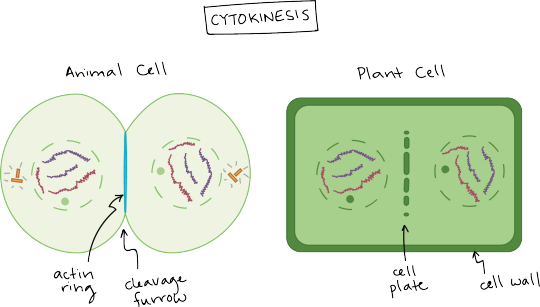
Cytokinesis in animal and plant cells.
Cytokinesis in an animal cell: an actin ring around the middle of the cell pinches inward, creating an indentation called the cleavage furrow.
Cytokinesis in a plant cell: the cell plate forms down the middle of the cell, creating a new wall that partitions it in two.
Cytokinesis, the division of the cytoplasm to form two new cells, overlaps with the final stages of mitosis. It may start in either anaphase or telophase, depending on the cell, and finishes shortly after telophase.
In animal cells, cytokinesis is contractile, pinching the cell in two like a coin purse with a drawstring. The “drawstring” is a band of filaments made of a protein called actin, and the pinch crease is known as the cleavage furrow. Plant cells can’t be divided like this because they have a cell wall and are too stiff. Instead, a structure called the cell plate forms down the middle of the cell, splitting it into two daughter cells separated by a new wall.

When division is complete, it produces two daughter cells. Each daughter cell has a complete set of chromosomes, identical to that of its sister (and that of the mother cell). The daughter cells enter the cell cycle in G1.
When cytokinesis finishes, we end up with two new cells, each with a complete set of chromosomes identical to those of the mother cell. The daughter cells can now begin their own cellular “lives,” and – depending on what they decide to be when they grow up – may undergo mitosis themselves, repeating the cycle.
5 notes
·
View notes
Text

Mitosis is the essential process by which our cells duplicate themselves. In this simplified guide, we'll break down the stages of mitosis into easy-to-understand steps, so you can grasp the magic that happens at the cellular level.

Interphase: The cell duplicates its DNA and makes internal and external preparations for reproduction.

Prophase: Chromatin condenses into visible chromosomes, centrosomes move to opposite cell poles, and the nuclear membrane disintegrate.

Metaphase: Chromosomes align along the metaphase plate, with spindle fibers maintaining appropriate alignment and separation.

Anaphase: Sister chromatids of replicated chromosomes split and travel to opposing cell poles through spindle fibers, resulting in two sets of chromosomes that are identical.

Telophase: Occurs when the chromosomes reach opposite poles and the nuclear membrane begins to rebuild around each set of chromosomes. The cell prepares for cytokinesis when its chromosomes separate and spindle fibers disassemble.

Cytokinesis: When a cell divides into two daughter cells, each with its own set of chromosomes, this is referred to as cytokinesis which is the final stage of the process.
Overall, Mitosis is a crucial cellular process that aids in growth, repair, and maintenance of the body. It involves the intricate movement of genetic material within cells, highlighting the extraordinary wonders of life even at the smallest scale.
4 notes
·
View notes
Photo

Past Photo Favorites - A New Mexico Whiptail Lizard. This whiptail, is female, in fact all of this species are female. “Several Species of Female whiptail lizards from the southwestern United States and Mexico, (including New Mexico Whiptails), are capable of producing viable offspring without the help of fertilization. In fact, they’re so good at it that the species consists only of females. No males are known to exist. The lizards (from the genus Aspidoscelis) reproduce via parthenogenesis, a process in which eggs develop into embryos without first being fertilized. Although the lizards reproduce asexually, the offspring are not clones and don’t always have the same chromosomes as their mother. This is because the eggs of the females start off with twice as many chromosomes as an individual that reproduces sexually; and, instead of pairing chromosomes, sister chromatids are combined to allow for recombination and genetic diversity. Scientists also believe that at some point in their history, whiptails mated with males of an entirely different species, resulting in hybridization and leading to genetic variation that is still beneficial to them today. But females still enjoy the companionship of other lizards. Despite the fact that the lizards don’t need a male partner, researchers have observed females engaging in mating behaviors with other females, which evidently enhances ovulation. This behavior, known as pseudo-copulation, is driven by progesterone and involves individuals switching between typical male and female sexual behaviors, depending on the state of their partner.” - Samantha Hartery in Roaring Earth #PastPhotoFavorites #Lizard #Lizards #NewMexicoWhiptail #WhiptailLizard #AllFemaleLizardSpecies #Naturalist #PhotoByJeriRae (at Santa Fe, New Mexico) https://www.instagram.com/p/CohlgJuubJM/?igshid=NGJjMDIxMWI=
#pastphotofavorites#lizard#lizards#newmexicowhiptail#whiptaillizard#allfemalelizardspecies#naturalist#photobyjerirae
6 notes
·
View notes